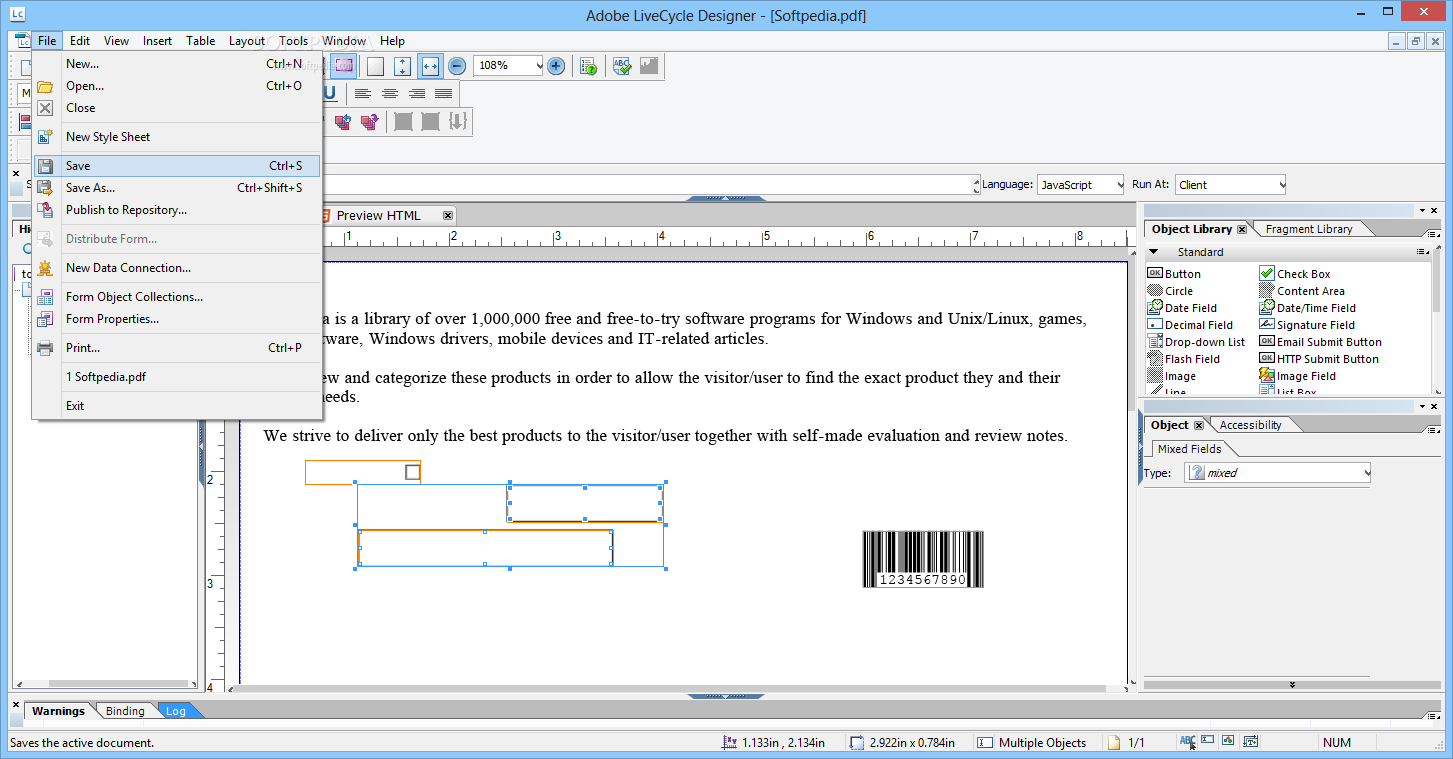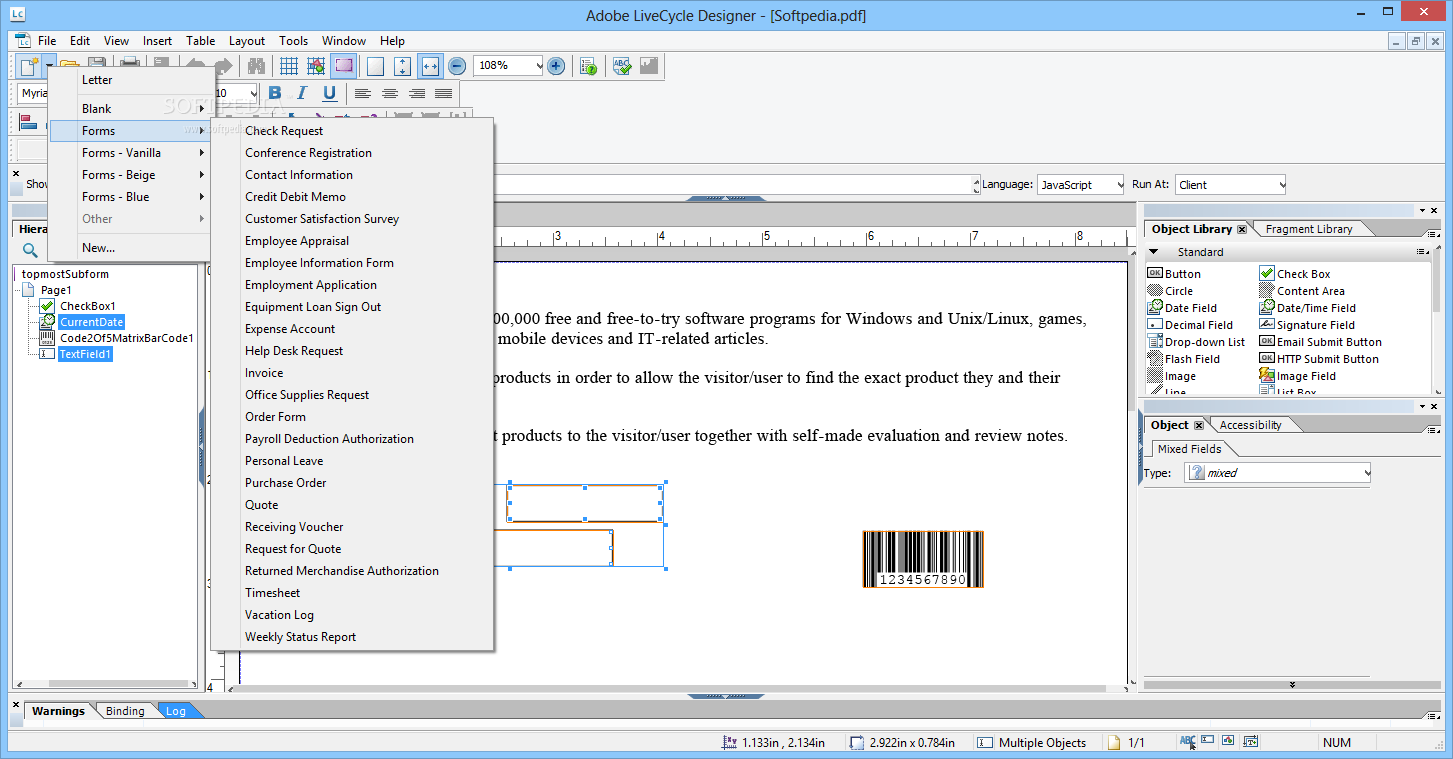Adobe Livecycle Version 11
You're viewing help content for version:
- LiveCycle Designer was included with Adobe Acrobat Pro Version 9. It is included in Adobe Acrobat X Pro as Adobe LiveCycle Designer ES2, but it is sold separately since Adobe Acrobat XI Pro. However, owners of a prior licensed version of Acrobat Professional who qualify for and purchase an upgrade to Adobe Acrobat XI Professional also qualify.
- Feb 26, 2018 I need to open/edit the.ifd files. But I'm not sure if Abobe LiveCycle is the right tool? Do you know where can I download LiveCycle Designer trial.
- Adobe LiveCycle Enterprise Suite (ES4) is a service-oriented architecture Java EE server software product from Adobe Systems used to build applications that automate a broad range of business processes for enterprises and government agencies. LiveCycle ES4 is an enterprise document and form platform that allows capturing and processing.
This Target Version Reference identifies which Adobe® LiveCycle® Designer 11 properties are supported by each target version of Adobe® Reader® and Adobe® Acrobat®. Use this reference for forms developed in Designer. Select Start Adobe LiveCycle Workbench 11 to launch Workbench and click Next. 8 Review the Release Notes and click Done. 9 The following items are now installed on your computer: † Workbench: To run Workbench from the Start menu, select All Programs Adobe LiveCycle ES4 Workbench 11, if you chose to store the shortcut folder there.
- 6.5
Adobe Experience Manager (AEM) LiveCycle connector enables seamless invocation of Adobe LiveCycle ES4 Document Services from within AEM web apps and workflows. LiveCycle provides a rich client SDK, which allows client applications to start LiveCycle services using Java APIs. AEM LiveCycle Connector simplifies using these APIs within the OSGi environment.
AEM LiveCycle Connector is part of the AEM Forms add-on package. After installing the AEM Forms add-on package, perform the following steps to add details of LiveCycle server to AEM Web Console.
- In AEM web console configuration manager, locate the Adobe LiveCycle Client SDK configuration component.
- Click the component to edit the configuration server URL, user name, and password.
- Review the settings and click Save.
Although the properties are self explanatory, the important ones are as follows:
- Server URL - Specifies URL to the LiveCycle server. If you want LiveCycle and AEM to communicate over https, start AEM with the following JVM argument
-Djavax.net.ssl.trustStore=<path to LC keystore> option. - Username - Specifies user name of the account which is used to establish communication between AEM and LiveCycle. The account is a LiveCycle user account who has the permissions to start Document Services.
- Password - Specifies the password.
- Service Name - Specifies the services which are started using the user credentials provided in Username and Password fields. By default, no credentials are passed while starting LiveCycle services.
Client applications can programmatically start LiveCycle services using a Java API, Web Services, Remoting, and REST. For Java clients, the application can use LiveCycle SDK. The LiveCycle SDK provides a Java API for starting these services remotely. For example, to convert a Microsoft Word Document to PDF, the client starts GeneratePDFService. The invocation flow consists of the following steps:
Each service provides a client class. To start a service, create a client instance of the service.
Adobe Livecycle Version 11 Free
- Client instances as OSGi Service: The clients packaged as OSGI bundles are listed in the Document Services list section. Each client jar registers the client instance as OSGi service with the OSGi Service Registry.
- User Credential Propagation: The connection details required to connect to LiveCycle server are managed at a central place.
- ServiceClientFactory Service: To start the processes, client application can access the ServiceClientFactory instance.
Starting via Service References from OSGi Service Registry
To start an exposed service from within AEM, perform the following steps:
Determine maven dependencies. Add dependency to the required client jar in your maven pom.xml file. At a minimum, add dependency to adobe-livecycle-client and adobe-usermanager-client jars.
To start a service, add corresponding Maven dependency for the service. For the list of dependencies, see Document Service List. For example, for the Generate PDF service add the following dependency:
Obtain the service reference. Get a handle to the service instance. If you are writing a Java class, you can use the Declarative Services annotations.
The above code snippet starts the createPDF API of GeneratePdfServiceClient to convert a document to PDF. You can perform similar invocation in a JSP using the following code. The major difference is the following code uses Sling ScriptHelper to access the GeneratePdfServiceClient.
The ServiceClientFactory class is required in some cases. For example, you require ServiceClientFactory to call processes.
Almost every Document Service in LiveCycle requires authentication. You can use any of the following options to start these services without providing explicit credentials in the code:
LiveCycle Client SDK configuration contains a setting about service names. This configuration is a list of services for which the invocation logic uses administrator credential out of the box. For example, if you add DirectoryManager services (part of User Management API) to this list, any client code can directly use the service and the invocation layer automatically passes on the configured credentials as part of the request sent to the LiveCycle server
As part of the integration, a new service RunAsManager is provided. It allows you to programmatically control credential to be used when making call to LiveCycle server.
If you want to pass different credential, you can use the overloaded method that takes a PasswordCredential instance.
If you call a process or make direct use of the ServiceClientFactory class and create an InvocationRequest, you can specify a property to indicate that invocation layer should use configured credentials.
The following services are available:
- com.adobe.idp.um.api.AuthenticationManager
- com.adobe.idp.um.api.DirectoryManager
- com.adobe.idp.um.api.AuthorizationManager
- com.adobe.idp.dsc.registry.service.ServiceRegistry
- com.adobe.idp.dsc.registry.component.ComponentRegistry
The following services are available:
- com.adobe.livecycle.dsc.clientsdk.security.RunAsManager
- com.adobe.livecycle.dsc.clientsdk.ServiceClientFactoryProvider
The following services are available:

- com.adobe.idp.taskmanager.dsc.client.task.TaskManager
- com.adobe.idp.taskmanager.dsc.client.TaskManagerQueryService
- com.adobe.idp.taskmanager.dsc.client.queuemanager.QueueManager
- com.adobe.idp.taskmanager.dsc.client.emailsettings.EmailSettingService
- com.adobe.idp.taskmanager.dsc.client.endpoint.TaskManagerEndpointClient
- com.adobe.idp.taskmanager.dsc.client.userlist.UserlistService
The following service is available:
- com.adobe.idp.workflow.client.WorkflowServiceClient
The following service is available:
- com.adobe.livecycle.generatepdf.client.GeneratePdfServiceClient
Adobe LiveCycle Application Manager Client bundle
The following services are available:
- com.adobe.idp.applicationmanager.service.ApplicationManager
- com.adobe.livecycle.applicationmanager.client.ApplicationManager
- com.adobe.livecycle.design.service.DesigntimeService
The following service is available:
- com.adobe.livecycle.assembler.client.AssemblerServiceClient
Adobe LiveCycle Form Data Integration Client bundle

The following service is available:
- com.adobe.livecycle.formdataintegration.client.FormDataIntegrationClient
The following service is available:
- com.adobe.livecycle.formsservice.client.FormsServiceClient
The following service is available:
- com.adobe.livecycle.output.client.OutputClient
The following service is available:
Jul 23, 2019 The system requirements for Windows 8.1 and Windows RT 8.1 are nearly the same as the requirements for Windows 8—if your PC is already running Windows 8 (or Windows RT), in most cases, you can get the free update to Windows 8.1 (or Windows RT 8.1). Aug 31, 2016 Windows 8.1 Update and Windows RT 8.1 Update (also known as KB 2919355) include improvements that make your favorite apps and settings easier to find and use, provide more familiar mouse and keyboard options, and update security and performance. Here’s what you need to know about installing this important update. Jun 17, 2019 How to Upgrade from Windows 8 to 8.1. Upgrading from Windows 8 to Windows 8.1 allows you to enjoy the latest features and updates released by Microsoft, as well as security enhancements that can help protect your computer and personal. Upgrade to Windows 8.1 with Upgrade Assistant. Microsoft allows you to purchase, download and install Windows 8.1 over the web. If you have a slow internet connection or prefer to upgrade the. Upgrade windows 8 to 8.1.
- com.adobe.livecycle.readerextensions.client.ReaderExtensionsServiceClient
The following services are available:
- com.adobe.livecycle.rightsmanagement.client.DocumentManager
- com.adobe.livecycle.rightsmanagement.client.EventManager
- com.adobe.livecycle.rightsmanagement.client.ExternalUserManager
- com.adobe.livecycle.rightsmanagement.client.LicenseManager
- com.adobe.livecycle.rightsmanagement.client.WatermarkManager
- com.adobe.livecycle.rightsmanagement.client.PolicyManager
- com.adobe.livecycle.rightsmanagement.client.AbstractPolicyManager
The following service is available:
- com.adobe.livecycle.signatures.client.SignatureServiceClientInterface
The following services are available:
- com.adobe.truststore.dsc.TrustConfigurationService
- com.adobe.truststore.dsc.CRLService
- com.adobe.truststore.dsc.CredentialService
- com.adobe.truststore.dsc.CertificateService
The following services are available:
- com.adobe.repository.bindings.ResourceRepository
- com.adobe.repository.bindings.ResourceSynchronizer
More like this
Twitter™ and Facebook posts are not covered under the terms of Creative Commons.
Adobe Version 11 Free Download
Legal Notices Online Privacy Policy